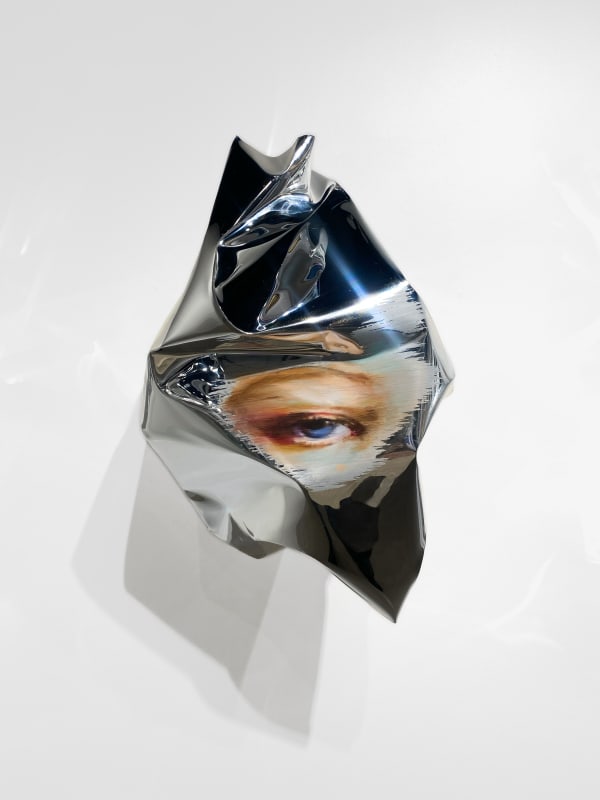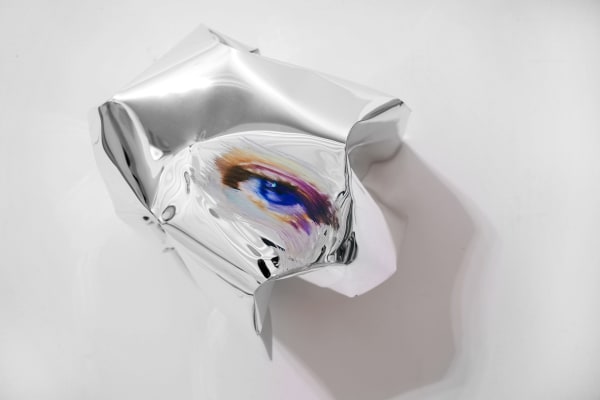Martin C. Herbst is an Austrian painter whose work focuses on the re-evaluation of historical themes, classical portrait theories, and the human figure. His wish is to reinterpret the traditional paintings of the great portraitists in the history of art, such as Parmigianino, Velasquez, and Rembrandt, in a modern and thoughtful perspective. Martin C. Herbst realizes sensitive interpretations of different models, depending strictly on his own state of mind. Having the habit of producing several versions of the same portrait, we can perceive the evolution of the emotional state of the artist through the representation of the same figure. There is a certain notion of homage found in the works of Martin C. Herbst, since by taking up these known figures he proclaims highly the value of the manner and touch of the artists he cites.
In the Spheres series, faces appear on one-half of mirror-polished spheres and look like mysterious moon faces. The artist uses highly polished stainless steel spheres and paints a distorted face on one half. The other half of the sphere remains unpainted and functions as a powerful distorting mirror. This series is inspired by a famous painting of the Italian Mannerist, Parmigianino’s Self-portrait in a Convex Mirror.
In the sculptural series Hidden Treasure, painting and mirrors are amalgamated, transforming tangible paint into an ephemeral and virtual manifestation. As a result of the complex folds in the mirrored aluminum, most of the actual painting is only seen in its reflection. The painting seems to take life and even become animated because the part of the mirror producing the reflection is uneven. As soon as the beholder begins to explore its secrets by moving from side to side, the work unfolds a surprising array of subtly shifting reflections of the painted image.
Oil painting offers Martin C. Herbst an ideal opportunity to paint historical connotations of art. Using aluminum rather than a more traditional canvas as an image support, it automatically evokes the contemporaneity of his painting. The reflective and non-absorbing properties of aluminum thus allow the release of the oil paint, which now exists independently of the substrate on which it is applied, creating a dematerialized effect that suggests a painting of renewed purity. Reinforced by the artist’s expressive and characteristic touch, a new tension appears between traditional painting, photorealism and electronic image.
In the Garden of Delights series, flowers make a grand entrance in the staging of large panels. The curved background’s mirrored surface produces permanently shifting distorted reflections of the beholder and the space around the painting. The flower seems animated because our eye and brain cannot process the perception of an image deriving from a solid object in which parts change dynamically and others remain stable.
Paintings on flat aluminum plates and paintings on canvas were the starting point of Martin C. Herbst´s artistic career and still play an important role in his work with the series Maria Magdalena, Bella and others.
Originally from Vienna in Austria, Martin C. Herbst has been exhibited extensively throughout the world, most recently in San Jose, Beirut, Toronto, New York, Barcelona, and Montreal. His work has been featured in numerous trade shows, including Art Basel (Miami), Armory Show (New York), Scope (New York, Basel, Hamptons, London), Art Chicago, Los Angeles Art Show, Artbo (Bogota), Art Brussels (Brussels), ArteBa (Buenos Aires) and several others.
 Painters Fate 11, 2025
Painters Fate 11, 2025 Lenissima 18, 2025
Lenissima 18, 2025 Painters Fate 13, 2025
Painters Fate 13, 2025 Lenissima 19, 2025
Lenissima 19, 2025 Painters Fate 15, 2025
Painters Fate 15, 2025 Wave 12, 2025
Wave 12, 2025 Painters Fate 16, 2025
Painters Fate 16, 2025 Wave 13, 2025
Wave 13, 2025 Painters Fate 17, 2025
Painters Fate 17, 2025 Wave 14, 2025
Wave 14, 2025 Painters Fate 18, 2025
Painters Fate 18, 2025 Wave 17, 2025
Wave 17, 2025 Painters Fate 22, 2025
Painters Fate 22, 2025 Wave 18, 2025
Wave 18, 2025 Wave 19, 2025
Wave 19, 2025 Wave 1, 2019
Wave 1, 2019 God 21 (Garden of Delights), 2018
God 21 (Garden of Delights), 2018 Painter's Fate 1, 2019
Painter's Fate 1, 2019 Painter's Fate 2, 2019
Painter's Fate 2, 2019 Painter's Fate 6, 2019
Painter's Fate 6, 2019 Painter's Fate 7, 2019
Painter's Fate 7, 2019 Painter's Fate 5, 2019 Sold
Painter's Fate 5, 2019 Sold Painter's Fate 4, 2019 Sold
Painter's Fate 4, 2019 Sold ReRe.2.V.40 (series ReRenaissance), 2019 Sold
ReRe.2.V.40 (series ReRenaissance), 2019 Sold Hidden Treasures 49, 2016 Sold
Hidden Treasures 49, 2016 Sold Sphere V36, 2016 Sold
Sphere V36, 2016 Sold Lena Sphere 13, 2015 Sold
Lena Sphere 13, 2015 Sold Painter's Fate 8, 2019 Sold
Painter's Fate 8, 2019 Sold Painter's Fate 3, 2019 Sold
Painter's Fate 3, 2019 Sold Hidden Treasures 73, 2016 Sold
Hidden Treasures 73, 2016 Sold Wave 5, 2024 Sold
Wave 5, 2024 Sold


































